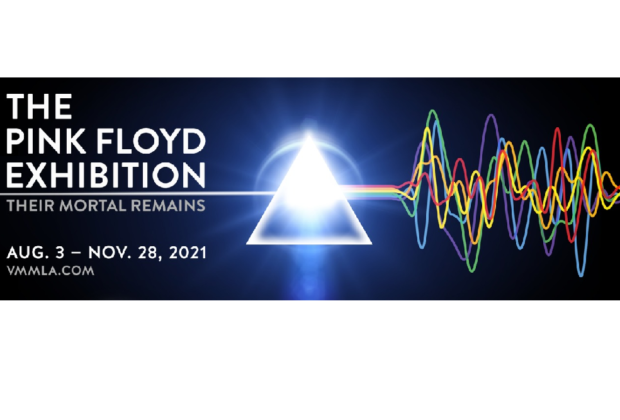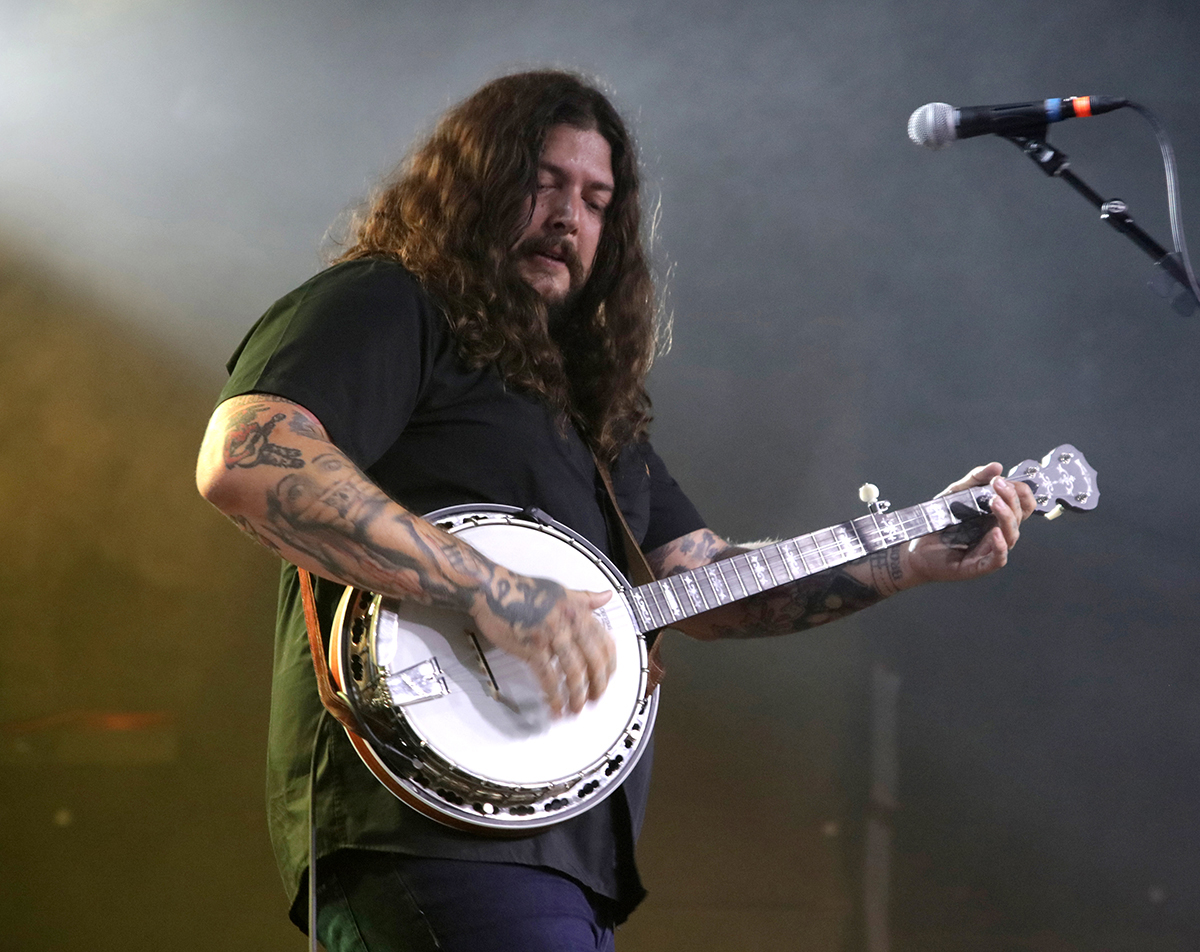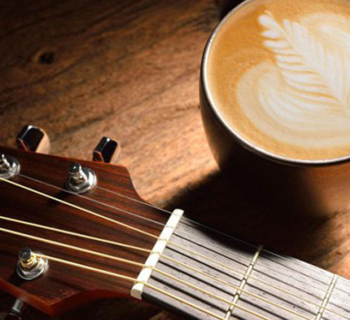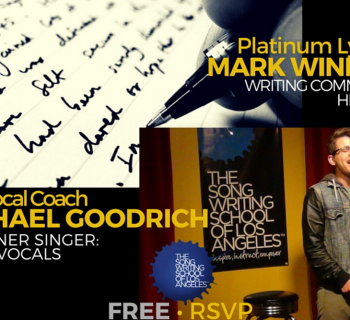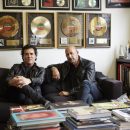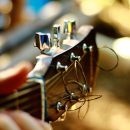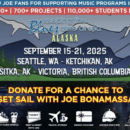Due to the restriction of port capacity limits, the opening of The Pink Floyd Exhibition: Their Mortal Remains has been postponed to September 3. While Pink Floyd and the exhibit team shipped the artifacts from the UK in plenty of time for the August opening, the Los Angeles ports are still operating at half capacity causing a major delay in processing shipping containers and unfortunately, the artifacts are still detained.
The exhibition presents a critically acclaimed major retrospective of Pink Floyd, their music, and the impact the band had on art and culture. Following its hugely successful debut at London’s Victoria and Albert Museum in 2017, which saw over 400,000 people attend, the Exhibition will now take residency in Los Angeles. Crossing the Atlantic for the first time the Exhibition will open September 3 at the Vogue Multicultural Museum on Hollywood Boulevard. This historical landmark is the perfect venue for the immersive experiential journey through Pink Floyd’s world, from high-tech audiovisual events, objects, and surreal landscapes that evolve throughout the Exhibition. Tickets for the Exhibition are on sale now via www.vmmla.com and www.pinkfloydexhibition.com. The Pink Floyd Exhibition is promoted by Michael Cohl of S2BN Entertainment, in association with LA event promoter Diego Gonzalez.
Diego says: “I feel very proud to have the opportunity to introduce a new era of cultural exhibitions for the city of Los Angeles, especially with the timeless and legendary Pink Floyd, a band so inspirational to myself and millions of fans all around the world for generations. This exhibition will be a really exciting opportunity for people to come together to experience music, culture, design and innovation, all principles that Pink Floyd represents in their music. I couldn’t imagine a better exhibition to inaugurate the Vogue Multicultural Museum in Hollywood.”
Interview with Diego Gonzalez
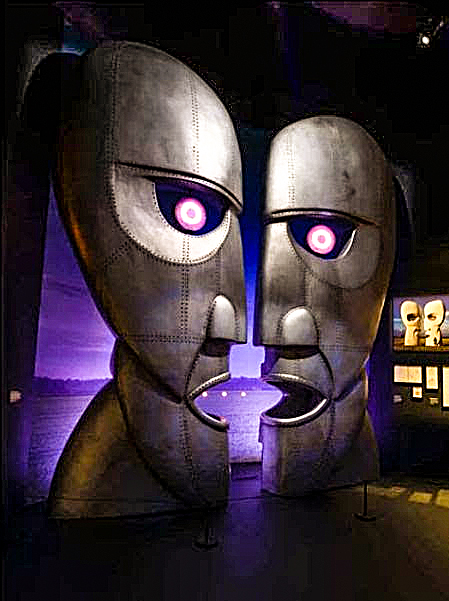 MC: When did you first discover Pink Floyd's music?
MC: When did you first discover Pink Floyd's music?
DG: Well, maybe I was in high school when I started getting a mind of my own. I was asking questions, tried to hear some different music, being more awake in my decisions… That’s when I heard Pink Floyd for the first time with my friends. It was a very nice experience. We had road trips listening to Pink Floyd and enjoying every second of it.
MC: What do you want the fans to get of this experience?
DG: I think Pink Floyd [music] is a very versatile experience and very spiritual in a way. It changed a lot of lives and the message they deliver is sentimental in a way. It empowers people to fight back the power. Don’t belong to this program. I think what fans could experience is just that it is very overwhelming with sentiments. Another thing is if you are not a fan you can experience this and learn from it. The visual concept and art of Pink Floyd is amazing and part of pop culture. This exhibition is very well made and overwhelms your senses. I think everybody will have their own experience. I hope everyone has a blast, enjoy it, and gets the best out of it. This experience doesn’t happen too often. It has the official artifacts as in the originals and might not come back to L.A. in a lifetime. I think people should take their time and come see something that has changed the history of music, art, movies, everything… That’s what I expect fans to experience and have a fun time.
MC: What is the most significant item on exhibit for you ?
DG: For me The Wall is a very cool part of the exhibition with all the theatricals, the teacher, the suits from the movie. The movie has a big impact. It makes you think a lot with the animation. The room of The Wall is a very significant part. I think each room has its history and takes you through it and is important. There might be things people never knew about that band and how they were inspired. I think that everyone has its touch, but of course The Wall I'm more connected to. That’s how I first knew about them. It’s always a theatrical experience when you see Roger Waters live playing that show. It’s always very impressive.
MC: How involved was the band with this?
DG: The band is 100% involved in this exhibition. It’s their stuff, brand, and vision. Nick Mason is coming to the opening. They filled the exhibition with a curator Aubrey ‘Po’ Powell that has been with them the lifetime of the band. They got together and put this show on with Stufish a very famous group of architects for stages on the rock scene. They have done stages for Madonna, Lady Gaga [Rolling Stones, Elton John], you name it. Imagine having these minds that are very professional, very creative all together to set up something like this. There’s Pink Floyd the band, Stufish the main guys that build concert stages, Audrey ‘Po’ the curator, and Michael Cole. Everybody is a legend in this exhibition. They have been involved every step of the way.
MC: How did the Vogue get chosen?
DG: The Vogue is a new concept in L.A. I think it was chosen because we had some other shows back in the day doing exhibitions that were successful so we sent the offer to them and they liked the idea of it being in L.A. as the band is very connected here. When they come here to California, San Francisco or L.A. they always have sold out shows. They really have a great image of California. They were very happy bringing it to the U.S. for the first time via Los Angeles. There is a lot of history here for the band and their movement and vision. I think it was part of choosing the right space for people to see this.
MC: Who are a few other music artists you'd like to see an exhibit on?
DG: Every artist that has something to say. We like the Vogue multicultural museum. We call it that because we like the multicultural concept that any type of art can be approached and be seen. I’ve seen many exhibits David Bowie, Prince, Rolling Stones on the music side. Art in general is great and we will try to bring amazing exhibitions of this caliber of production, names, and good things for The Vogue
MC: How well has it sold in L.A. so far?
The tickets have sold very well, we have weekends already sold out. Coming out of the pandemic scenario I think people are waiting a little bit to be open. For the reaction of the people and how they like the exhibition and the artists we should be doing big numbers. I think the ticket sales will blow up more once we have it set up. The fans that really want to go already have their tickets and people might not find tickets in the future. We don’t have a big capacity because of restrictions and so many things inside like installations that make it limited so hurry up and buy your tickets.
As the first location outside of Europe, Los Angeles is the ideal destination to host the exhibition as the band has a rich history with the city, having rehearsed and performed there on many occasions. The Wall was completed and mixed in the famous city and in 1980 the group performed the first of 31 live shows at Los Angeles Memorial Sports Arena.
The Pink Floyd Exhibition is a collaboration between the members of Pink Floyd and curator, Aubrey ‘Po’ Powell. Developed closely with Nick Mason (Exhibition Consultant for Pink Floyd), the exhibition features over 350 artifacts collected over the band’s extraordinary career. It is an audio-visual journey through more than five decades of one of the most iconic groups, and a rare glimpse into the world of Pink Floyd. The exhibition is a collaboration with designers Stufish, entertainment architects, and the band’s long-standing stage designers.
Each chapter of the Pink Floyd story is represented, with objects and artifacts displayed, many unseen before the exhibition. There are handwritten lyrics, musical instruments, letters, original artwork, and many stage props. Some of these items have long been held in storage facilities, film studios, and in the personal collections of band members before being ‘dusted off’ for the exhibition.
From the entry point into The Pink Floyd Exhibition the visitor is immersed in Pink Floyd’s world. They will find themselves transported to the band’s beginnings in 1967 on the underground scene in 1960’s London including pictorial examples of the atmospheric oil and light projections as well as the equipment used by Pink Floyd’s 1960s-era lighting designer, Peter Wynne Willson. You will be assailed by a chronological trip through Pink Floyd’s history, connecting with music, art and design, sound technology and live performance via landmark albums such as The Dark Side Of The Moon, Wish You Were Here, Animals, The Wall, and The Division Bell.
Art and technology are celebrated, including an original painting by Syd Barrett, who studied art in London and Cambridge before becoming a full-time musician as well as a replica of the famed mirrored Fender guitar that Syd liked to play on stage and Syd’s sketch of how he envisaged the first Pink Floyd lineup. Also featured is the Azimuth Co-Ordinator, the custom-built device used by Richard Wright to pan the group’s live sound, via a joystick, around any given venue. The Azimuth played an integral part in Pink Floyd’s theatrical live performances at venues such as London’s Royal Festival Hall and Royal Albert Hall in the late 1960s as well as on the recording of the clock montage for ‘Time’ on The Dark Side of the Moon.
Pink Floyd’s journey through the 1970s saw them embracing studio technology and using all the resources at their disposal at EMI’s Abbey Road Studio on albums such as Meddle, The Dark Side Of The Moon, and Wish You Were Here. Several instruments used in those years are displayed here, including Nick Mason’s ‘Hokusai Wave’ drum kit from 1975 and a selection of David Gilmour’s equipment and artifacts, and Roger Waters’ Ovation bass guitar from ‘74 – ‘78. Also included are Pink Floyd’s soundtracks for the art-house movies, More, La Vallée and Zabriskie Point; musical projects undertaken around their studio albums, and excerpts from the acclaimed Pink Floyd 1972 film, ‘Live At Pompeii ‘.
The now world-famous artwork for 1973’s The Dark Side Of The Moon was created by Hipgnosis, the design partnership founded by exhibition co-curator Aubrey ‘Po’ Powell and the late Storm Thorgerson. Hipgnosis’ work is on display throughout the exhibition, alongside artwork and stage designs created for the band by others, including Gerald Scarfe (whose very first drawing of the band is included in the comic book program on display from 1974) and the late Mark Fisher.
These artifacts plot both Pink Floyd’s development as a spectacular live band and the broader social, cultural and political threads which ran parallel to their music. Among the many artwork pieces on display is alternative imagery of architect Giles Gilbert Scott’s Battersea Power Station, the building immortalized by Roger Waters’ interpretation on the cover of Pink Floyd’s 1977 the album, Animals, with the flying pig, Algie, and the only remaining model sheep which was fired from mortars and parachuted over the audience during the ’77 In The Flesh tour of the US.
In 1979, Roger Waters conceived The Wall which explored childhood alienation, the Second World War, the loss of his father, through to the rites of passage of a rock star. The album’s striking artwork and its grotesque cast of characters, including a huge inflatable cane-wielding schoolteacher, were created by cartoonist and illustrator Gerald Scarfe. Also, some of Roger’s original biro sketches and lyrics for The Wall accompanied by a mannequin cloaked in his black leather coat and megaphone from the 2010/2013 The Wall shows.
These characters were then re-imagined by Mark Fisher as huge inflatables in the subsequent Wall stage show, some of which have been re-created by Stufish and will feature in the exhibition. Included in the exhibition is the cane used by the headmaster at the Cambridge and County High School for Boys on his pupils, Roger Waters, Syd Barrett, and future collaborator Storm Thorgerson and a punishment book detailing the dates and reasons for the beatings, all inspiration for the schoolteacher character and the song Another Brick In The Wall Pt 2.
Later in 1987, Pink Floyd returned to Los Angeles to record their debut album without Roger called A Momentary Lapse of Reason. The scale and ambition of Pink Floyd’s imagery and live shows continued from the late 1980s and mid-'90s with world tours for the A Momentary Lapse Of Reason and The Division Bellalbums. The exhibition salutes this scale and ambition with specially reconstructed suits of lightbulbs worn by two mannequins mimicking the cover of the 1988 live album, Delicate Sound Of Thunder which was photographed near Madrid in 1989, and the giant metal and stone ‘talking heads’ conceived by Storm Thorgerson for the sleeve of 1994’s The Division Bell.
The flow of the exhibition, in chronological order, is enhanced throughout by music and the voices of past and present members of Pink Floyd, including Syd Barrett, Roger Waters, Richard Wright, Nick Mason, and David Gilmour, talking about their experiences and musical experimentation via an intuitive audio guide system. This culminates in the Performance Zone, where visitors enter an immersive audio-visual space, which includes Pink Floyd classic tracks as well as the recreation of the very last performance of David Gilmour, Roger Waters, Richard Wright, and Nick Mason, performing Comfortably Numb at Live 8 in 2005.
- Admission prices from $30 to $46 (plus applicable fees), audioguide included in the price
- Venue: Vogue Multicultural Museum, 6675 Hollywood Blvd, Los Angeles
- Venue website: www.vmmla.com

